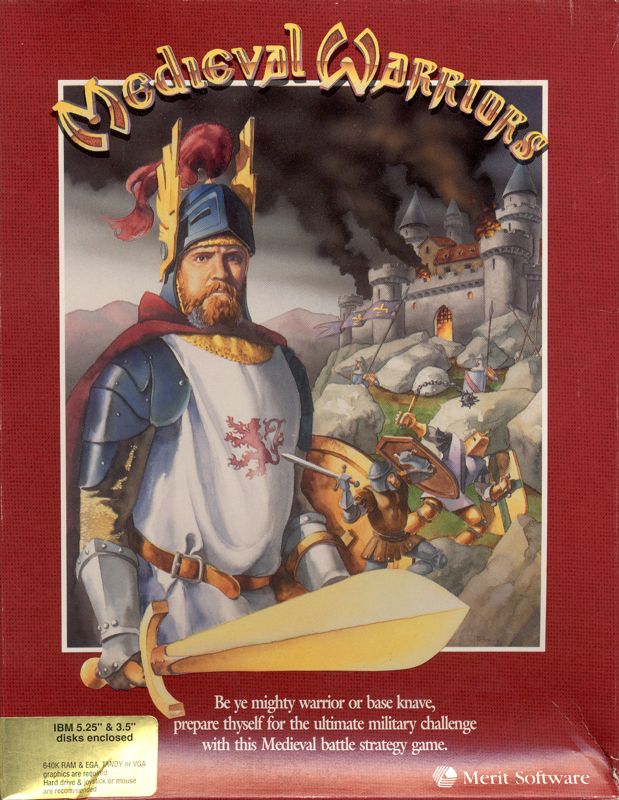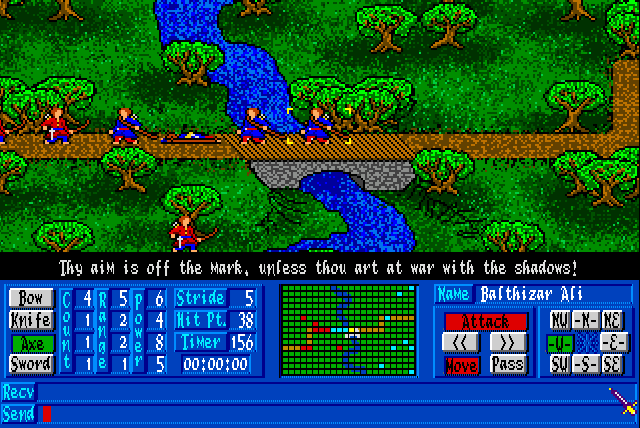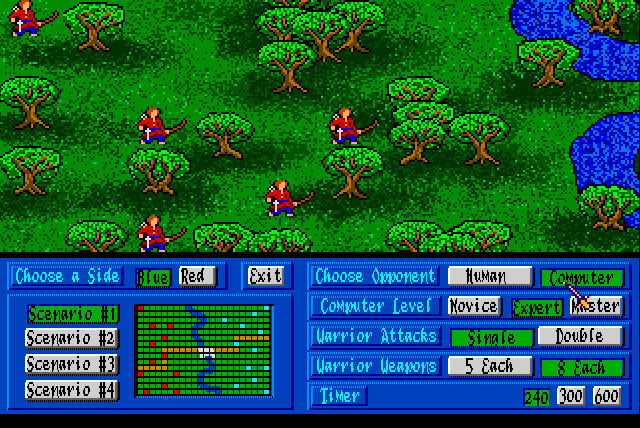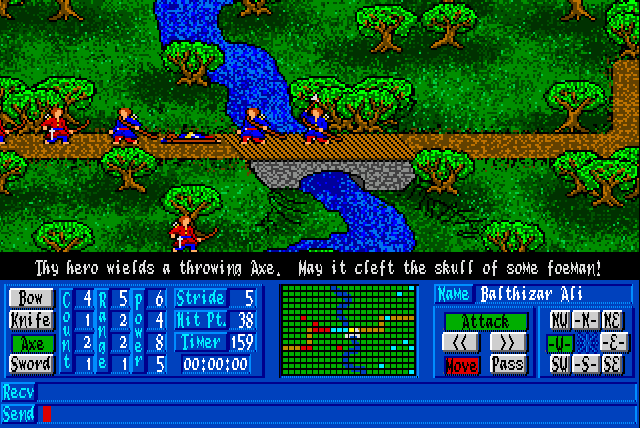Retro Replay Review
Gameplay
Medieval Warriors brings a classic turn-based strategy experience to modern audiences by combining thoughtful unit management with terrain-based tactics. Each side—Blue or Red—controls a dozen warriors, each uniquely named and statted, and the game unfolds across four distinct battlefield maps. Whether you’re navigating the narrow corridors of the Castle Keep or maneuvering around the forest and pond in Frontier Outpost, every decision counts: from who leads the charge to which weapon to draw in the heat of combat.
(HEY YOU!! We hope you enjoy! We try not to run ads. So basically, this is a very expensive hobby running this site. Please consider joining us for updates, forums, and more. Network w/ us to make some cash or friends while retro gaming, and you can win some free retro games for posting. Okay, carry on 👍)
Unit differentiation is at the heart of the gameplay loop. Warriors vary by movement range, hit points, and starting equipment, and players must balance offensive and defensive roles carefully. Swords are reliable in close quarters, bows offer ranged harassment, and spears provide versatile mid-range engagements. Since weapons have limited durability, judicious resource management becomes a strategic layer: do you press the offensive at the risk of depleting your best blades, or conserve equipment and play defensively?
The enemy AI—an improvement over Medieval Warriors’ ancestor TeleEpic—provides a respectable solo challenge. Opponents make purposeful advances, coordinate attacks, and exploit terrain strengths. For those seeking a more unpredictable test, the modem-based human-versus-human mode rekindles the tension of competitive play. Matches can be intensely personal as you attempt to outwit a live opponent, jockey for advantageous positions, and deny critical chokepoints.
The turn-based system allows you to stop and consider every move without the pressure of a ticking clock, yet the game rarely feels stagnant. Quick retirements of veteran units can drastically shift the momentum, forcing you to adapt mid-battle. This ebb and flow of battlefield fortunes keeps each skirmish engaging, whether you’re plotting a well-timed ambush in the woods or orchestrating a flanking assault through narrow hallways.
Graphics
Graphically, Medieval Warriors sports charming, early 1990s pixel art that evokes nostalgia for the era of DOS-based strategy titles. Units are rendered clearly, with distinct color palettes for the Blue and Red teams ensuring visual readability even in the thick of combat. Terrain features—trees, water, walls—are easily distinguished, which is crucial when planning movement and cover.
The animation is modest but effective: warriors raise swords in a clear striking motion, arrows arc through the air, and defeat is signaled by a simple but recognizable collapse. While these animations lack the flourishes of modern high-definition titles, they convey all necessary information without cluttering the battlefield. The UI embraces a minimalist approach, giving quick access to unit stats, remaining weapon durability, and movement grids.
Map design showcases thoughtful variety. Frontier Outpost’s open spaces punctuated by ponds and forests contrast nicely with Castle Keep’s tighter indoor layout. These environmental shifts not only affect tactical decisions but also keep the visuals fresh across multiple sessions. The game’s color scheme remains consistent, avoiding overly bright palettes that could fatigue the eyes during extended playions.
In an age of real-time 3D graphics, Medieval Warriors’ pixel-based visuals may feel rudimentary, but they capture a nostalgic charm. For enthusiasts of retro strategy experiences, the graphics are part of the appeal—simple, clear, and functional, allowing you to focus on the meat of the gameplay without distraction.
Story
Unlike sprawling RPGs with deep lore, Medieval Warriors opts for a straightforward premise: two rival factions vie for dominance on varied battlefields. The narrative unfolds implicitly through map selection and the unique names and portraits of the twelve warriors on each side. While there’s no overarching cinematic story reel, the game’s heart lies in the emergent tales you craft—heroic last stands, daring rescues, and bitter rivalries between named champions.
Each map offers a thematic backdrop: raiding the outskirts in Frontier Outpost suggests skirmishes on the empire’s edge, while Castle Keep conjures images of sieges within impregnable walls. This setting variety gives just enough narrative flavor to spark the imagination without bogging you down in cutscenes or text dumps. The focus remains squarely on battlefield theater rather than elaborate world-building.
For players who appreciate narrative context, the simple mission briefs are sufficient. You know your objectives—eliminate the enemy or capture key positions—and that urgency drives each turn. Although the story framework is deliberately light, it leaves space for you to insert your own legends: the archer who held the forest line, the knight who breached the keep, and the cunning general who outmaneuvered all expectations.
In essence, Medieval Warriors’ story is what you make of it. The game supplies the pieces—broader lore, diverse maps, and individual warriors with names—but is content to let strategic action write the tale. Fans of sandbox storytelling will find this approach liberating, while those seeking a scripted narrative might miss more structured plot development.
Overall Experience
Medieval Warriors stands as a testament to early turn-based strategy design. Its blend of unit customization, terrain-driven tactics, and durable equipment management creates a satisfying puzzle of decisions. Each match feels different as you adapt to map constraints, enemy AI behaviors, and the ebb and flow of fortune on the battlefield.
Replayability is high: with four diverse maps, twelve distinct warriors per side, and the option to challenge either a computer opponent or a human adversary via modem, the game offers countless fresh scenarios. Veterans can experiment with aggressive formations, defensive bastions, or weapon-conservation strategies, always learning new nuances in unit interaction and terrain exploitation.
While modern players may long for richer narratives or more detailed graphics, Medieval Warriors’ simplicity is its strength. It provides a focused, uncluttered tactical playground that rewards thoughtful play and careful planning. The game’s pacing—unhurried but never languid—ensures that even lengthy campaigns maintain tension and strategic depth.
For enthusiasts of retro strategy or newcomers curious about the genre’s roots, Medieval Warriors is a noteworthy journey into the past. Its core mechanics remain engaging decades after release, and its straightforward presentation allows the pure strategic challenge to shine. If you’re seeking a turn-based experience that prioritizes tactics over spectacle, this classic deserves a place in your library.
 Retro Replay Retro Replay gaming reviews, news, emulation, geek stuff and more!
Retro Replay Retro Replay gaming reviews, news, emulation, geek stuff and more!









Reviews
There are no reviews yet.